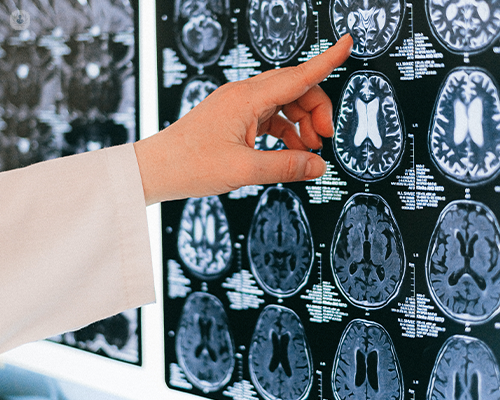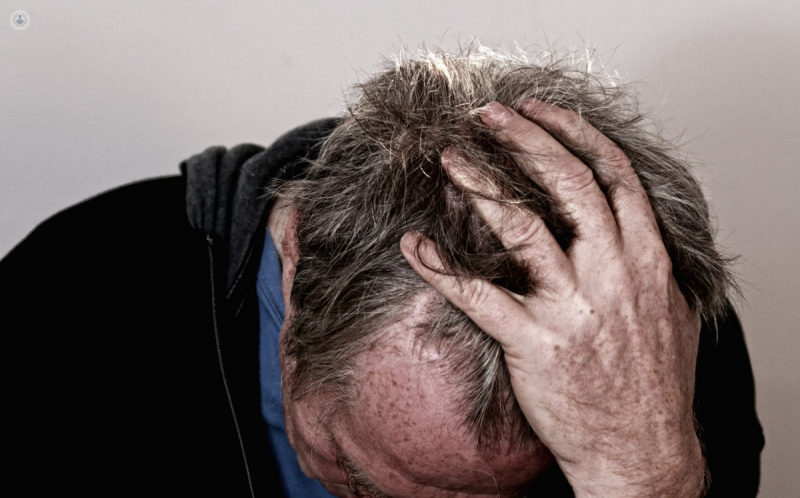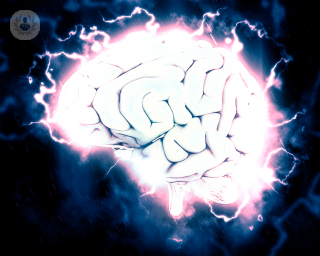Brain haemorrhage
What is a brain haemorrhage?
A brain haemorrhage is a rupture of a blood vessel (usually an artery) that causes bleeding in and around the brain. Brain haemorrhages differ according to their location and the severity of the damage:
- Spontaneous cerebral haemorrhage: associated with arterial hypertension, coagulation problems, tumours or formation of new blood vessels following ischemia, vasculitis, drugs, or central nervous system infections, amongst others. It may be an intraparenchymal or intracerebral haemorrhage, which usually affects older people. This type of brain haemorrhage accounts for 10 to 15 per cent of all strokes.
- Intraventricular haemorrhage: when the ventricles of the brain that contain the cerebrospinal fluid are affected. It affects premature infants, especially those who have had respiratory distress syndrome, a collapsed lung, or high blood pressure. In 70 per cent of cases, this haemorrhage is secondary; that is, it originates from an intraparenchymal haemorrhage.
- Subarachnoid haemorrhage: affects young people between the ages of 20 and 40. This is a serious pathology that is usually caused by the rupture of an aneurysm, head trauma, use of anticoagulants, bleeding disorder, etc. It is common in older people who have had falls or head injuries and in young people who have had a car accident.
- Subdural haematoma: this is the most common traumatic bleeding, where blood is collected between the surface of the brain and the skull, normally caused by a head injury. People with this condition often go into a coma during their hospitalisation.
- Epidural haematoma: this may be the result of brain trauma where the blood collects between the outermost protective layer of the brain (dura mater) and the skull. In most cases, it is caused by a skull fracture in children and adolescents.
What is the prognosis?
A brain haemorrhage is a serious pathology which may result in death. Brain haemorrhage has a mortality rate of 40 per cent. The main complications occur when the haematoma expands, because of perihematomal oedema, convulsions, hyperglycaemia, arterial hypertension, fever, and infection, amongst others. In general, the severity of each case will depend on the amount of bleeding.
What are the symptoms of a brain haemorrhage?
The main symptoms of a brain haemorrhage according to type are:
- Spontaneous cerebral haemorrhage: manifests with a headache, vomiting, and decreased consciousness, amongst others.
- Intraventricular haemorrhage: sleep apnoea and bradycardia, high-pitched cry, seizures, anaemia, swelling, or bulging of the soft spots between the bones of the baby's head.
- Subarachnoid haemorrhage: vision problems, muscle aches, sudden and severe headache, loss of consciousness, and nausea and vomiting, amongst others.
- Subdural haematoma: headache, difficulty with balance or walking, slurred speech, lack of energy, seizures, nausea and vomiting, vision problems, etc.
- Epidural haematoma: the main symptoms are dizziness, confusion, nausea or vomiting, drowsiness, head trauma and weakness, amongst others.
Other symptoms of a brain haemorrhage may be:
- seizures without previous history of seizures
- weakness in a leg or arm
- vision changes
- loss of coordination and/or balance
- difficulty with speech or understanding speech
How are they detected?
The first step in detecting a brain haemorrhage is to determine what type of haemorrhage it is, and this can be learned through CT and MRI scans. Blood tests, an electrocardiogram, carotid ultrasound, and brain angiography may also be performed to help determine the type, cause, and location, and to rule out other conditions.

What causes brain haemorrhages?
A brain haemorrhage may occur for non-obvious reasons or may be caused by a brain injury. Risk factors for brain haemorrhage include high blood pressure, menopause, diabetes, smoking, and alcohol and caffeine consumption.
Spontaneous cerebral haemorrhage as already mentioned, is usually related to high blood pressure. Some controllable risk factors are alcohol and tobacco, while another factor is diabetes mellitus. Intraventricular haemorrhage causes are not clear, although it may be due to the fact that the blood vessels in the baby's brain are very fragile and immature. People with respiratory problems are more susceptible. Bleeding almost always occurs during the first four days of life.
Subdural haematoma is often caused by a severe head injury, but it may also be the result of a minor head injury. Risk factors include anticoagulant medications, medical conditions, long-term alcohol use, etc. Epidural hematoma is often caused by a skull fracture during childhood or adolescence. It is more common in young people. It can also be caused by rupture of a blood vessel.
Can they be prevented?
Risk factors of brain haemorrhage can be prevented by:
- developing healthy habits
- controlling cholesterol
- controlling sugar levels
- controlling blood pressure
- lowering stress and controlling moods
- stopping smoking
- controlling weight
- not doing drugs
- driving carefully
- wearing a helmet for activities which require one
- following doctor's instructions when taking blood-thinners
Not all brain aneurysms may be preventable, but keeping risk factors as low as possible is the best prevention method.
How is a brain haemorrhage treated?
It is essential that a brain haemorrhage be treated immediately, to save your life and reduce the risk of disability. Treatment will depend on the type and location of the haemorrhage, but will generally be aimed at restoring blood flow and reducing pressure on the brain. If a brain haemorrhage is caused by a clot, it can be treated with drugs. Other treatments include surgery and intracranial vascular treatments.
What is recovery time like?
Recovery will depend on the type of haemorrhage, how soon it is caught and treated, the size, the location in the brain, and amount of bleeding. Some patients may recover completely, while others may take many months to recover. Other patients may require rehabilitation, focusing on physical, speech, and occupational therapy. Some problems may persist after treatment, such as weakness or sensory problems, seizures, headaches, adverse reactions to medications, or memory issues.
Unfortunately, death may still occur even if a brain haemorrhage has been caught and treated, though this is rare. The best way to increase your odds of survival is to recognise symptoms and seek treatment immediately.
Which specialist treats brain haemorrhages?
Brain haemorrhages are treated by neurosurgeons.




